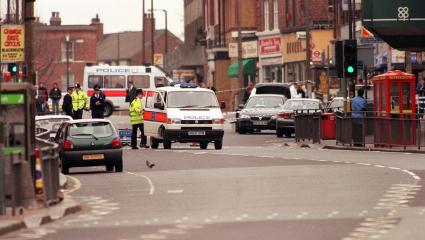
Oklahoma City Bombing: America's worst domestic terrorist attack
On the morning of 19th April 1995, the people of Oklahoma City woke up to what they thought would be a typical day. Children were dropped off at daycare, federal employees began their shifts and life carried on as usual. But by 9:02am, everything changed.
What followed was one of the deadliest and most heartbreaking attacks in U.S. history.
A massive explosion ripped through the Alfred P. Murrah Federal Building in the heart of the city. The blast could be felt miles away. It wasn’t just a terrible accident — it was a carefully planned act of domestic terrorism that killed 168 people.
Join us at Crime+Investigation as we explore the 1995 Oklahoma bombing. Discover the motive behind the attack, how it was carried out, and how it has impacted American society ever since.
A seemingly normal day
On a peaceful morning in April 1995, the people of Oklahoma City were preparing to begin their day. Little did they suspect that it would soon become the darkest day in the city’s history – and one that would leave the rest of the country stunned.
A seemingly ordinary rented Ryder truck had been parked outside the Murrah Federal Building. Inside, and hidden from view was a homemade bomb weighing over 4,800 pounds, made primarily made primarily of ammonium nitrate fertiliser, fuel oil and other chemicals. The bomb had been lit just minutes earlier.
At 9:02am, it detonated. The massive explosion destroyed nearly a third of the nine-story building and killed 168 people, including 19 children. The children were being looked after in a daycare centre located on the second floor.
More than 650 others were injured. The blast left a crater 30 feet wide and 8 feet deep. Nearby buildings were damaged or destroyed, and the devastation sent shockwaves far beyond the state of Oklahoma.
Who was Timothy McVeigh?
In the hours after the attack, there was widespread confusion. Initial speculation pointed to foreign terrorists, but within days, investigators had their sights on someone much closer to home.
That man was Timothy McVeigh, a former U.S. Army soldier. He had no prior criminal record but harboured deep resentment toward the federal government.
His radical views had been shaped over the years of reading anti-government literature. He became obsessed with events like the 1993 Waco Siege, in which federal agents clashed with members of a religious sect in Texas, resulting in dozens of deaths.
Spark a revolution
McVeigh saw the Oklahoma City bombing as revenge — a statement against what he saw as government tyranny. He believed the attack would spark a revolution. Instead, it led to shock, heartbreak and national mourning.
He didn’t act alone. He was aided by an old Army friend, Terry Nichols, who helped him acquire materials for the bomb and build the deadly device. Nichols wasn’t present during the actual bombing, but his involvement in the planning made him a key figure in the case.
Time for justice
The Ryder truck, which contained a vehicle identification number, was a crucial piece of evidence. Authorities were able to trace the rental back to McVeigh.
Just 90 minutes after the bombing, he had already been arrested in a traffic stop for driving without a license plate and carrying a concealed weapon. When investigators connected the dots, McVeigh was charged with the bombing.
The evidence against him was overwhelming: bomb-making materials in his hotel room, a receipt for ammonium nitrate and testimonies from people who saw him near the scene.
Terry Nichols was arrested shortly after and charged with conspiracy and involuntary manslaughter.
In 1997, McVeigh was convicted on 11 counts of murder and conspiracy and sentenced to death. He was executed by lethal injection on June 11, 2001. Nichols was also convicted and sentenced to life in prison without the possibility of parole.
Love true crime? Stay in the know with the Crime+Investigation Newsletter! Get exclusive access to new articles, episodes, clips, competitions, and more – delivered weekly and completely free. Don't miss out – sign up today!












